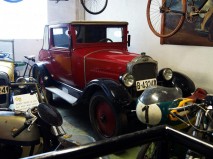1929 Opel 4/20
The Opel 4 PS, popularly known as the Opel Laubfrosch (Opel Treefrog), is a small two-seater car introduced by the then family owned auto maker Opel, early in 1924. Subsequently, various versions of the little Laubfrosch were produced until it was replaced by the Opel 1.2 litre, itself a direct ancestor of the first Opel Kadett.
Initially introduced as the Opel 4/12 PS, and manufactured at Opel’s Russelsheim plant, this was the first German car to be assembled on a Ford inspired production line.
At the end of 1928 the claimed maximum power from the engine increased to 20 PS (15 kW; 20 hp) at 3,500 rpm which pushed the listed top speed up to 77 km/h (48 mph). This was accompanied by a further change in the carburetor specification. Three seater bodies had by now disappeared from the list, but a new 2+2 cabriolet was introduced in 1930.
The naming convention by which the Laubfrosch had been known as the Opel 4 PS became in one respect obsolete in 1928, since it defined the car in terms of its tax horsepower (Steuer-PS). 1928 was the year in which the German finance office switched from levying annual tax according to "tax horsepower", taxing cars instead according to "Steuer-cm3" (tax cubic capacity). Many German cars continued to be named formally or informally according to tax horsepower through the early 1930s, but already in 1931 the Laubfrosch was sometimes known simply as the Opel 1.1, reflecting its engine size in litres rounded to the nearest 100cc, and following the naming convention which Opel adopted across their range in 1931.
Initially introduced as the Opel 4/12 PS, and manufactured at Opel’s Russelsheim plant, this was the first German car to be assembled on a Ford inspired production line.
At the end of 1928 the claimed maximum power from the engine increased to 20 PS (15 kW; 20 hp) at 3,500 rpm which pushed the listed top speed up to 77 km/h (48 mph). This was accompanied by a further change in the carburetor specification. Three seater bodies had by now disappeared from the list, but a new 2+2 cabriolet was introduced in 1930.
The naming convention by which the Laubfrosch had been known as the Opel 4 PS became in one respect obsolete in 1928, since it defined the car in terms of its tax horsepower (Steuer-PS). 1928 was the year in which the German finance office switched from levying annual tax according to "tax horsepower", taxing cars instead according to "Steuer-cm3" (tax cubic capacity). Many German cars continued to be named formally or informally according to tax horsepower through the early 1930s, but already in 1931 the Laubfrosch was sometimes known simply as the Opel 1.1, reflecting its engine size in litres rounded to the nearest 100cc, and following the naming convention which Opel adopted across their range in 1931.





